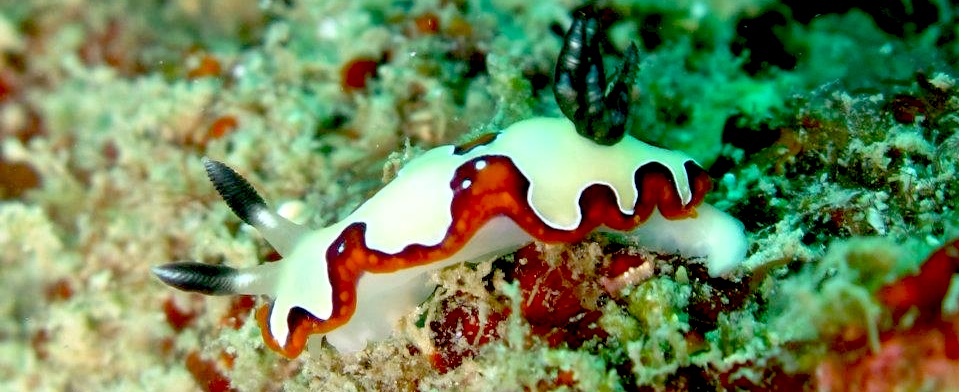
What is a Nudibranch?
Nudibranchs are Gastropods in the Phylum Mollusca
Or, said another way, nudibranchs are mollusks in the Class Gastropoda, which includes snails, slugs, limpets and sea hairs. Many gastropods have a shell. Nudibranchs have a shell in their larval stage, but it disappears in the adult form. Gastropods also have a foot (more on that below) and all young gastropods undergo a process called torsion in their larval stage. In this process, the entire top of their body twists 180 degrees on their foot, in other words, they turn themselves inside-out. This results in the placement of the gills and anus above the head (thus the name nudibranch, which means “naked lung” or “naked gill”) and adults that are asymmetrical in form.
All nudibranchs are sea slugs, but not all sea slugs are nudibranchs
The word nudibranch (pronounced nooda-brank) comes from the Latin word nudus (naked) and Greek brankhia (gills), in reference to the gills or gill-like appendages obviously sticking out from the backs of many nudibranchs. They also may have tentacles on their heads that help them smell, taste and get around. A pair of tentacles called rhinophores on the nudibranch’s head have scent receptors that allow the nudibranch to smell its food or other nudibranchs. Since the rhinophores stick out and can be a target for hungry fish, most nudibranchs have the ability to withdraw the rhinophores and hide them in a pocket in their skin if the nudibranch senses danger. The image is of Hilton’s aeolid (phidiana hiltoni). This nudibranch is missing a rhinophore. The image shows its oral tentacles (at front), one rhinophore (horn-like appendage on top) and cerata (flowing appendages on back.)
There are over 3,000 species of nudibranchs
There are over 3,000 species of nudibranchs, and new species are still being discovered. They range in size from a few millimeters to 12″ long, and can weigh up to just over 3 pounds. If you’ve seen one nudibranch, you haven’t seen them all. They come in a wide variety of colors and shapes – many have brightly colored stripes or spots and flamboyant appendages on their head and back. Nudibranchs are found in all the world’s oceans, from cold water to warm water. You might find nudibranchs in your local tide pool, while snorkeling or diving on a tropical coral reef, or even in some of the coldest parts of the ocean.
There are two main types of nudibranchs
Two main types of nudibranchs are dorid nudibranchs and eolid nudibranchs. Dorid nudibranchs, like the Limacia cockerelli shown here, breathe through gills that are on their posterior (back) end. Eolid nudibranchs have cerata – finger-like appendages that cover their back. The cerata can be a variety of shapes – thread-like, club-shaped, clustered, or branched. They have multiple functions, including breathing, digestion and defense.
Nudibranchs have a foot, and they leave a slimy trail
Nudibranchs move on a flat, broad muscle called a foot, which leaves a slimy trail. Nudibranchs are mostly found on the ocean floor, but some can swim short distances in the water column by flexing their muscles.
Nudibranchs have poor vision
While it’s obviously perfectly suitable to what a nudibranch needs to do in life, their vision is lackluster compared to our standards. They can see light and dark, but not their own brilliant coloration. With their limited vision, their sense of the world is obtained through their rhinophores (on top of the head) and oral tentacles (near the ‘mouth’).
Nudibranchs eat colorful food, which gives them their brilliant color
Nudibranchs eat using a radula. They are carnivorous – their prey includes sponges, coral, anemones, hydroids, barnacles, fish eggs, sea slugs, and other nudibranchs. Nudibranchs are picky eaters – individual species or families of nudibranchs may eat only one kind of prey. Nudibranchs get their bright colors from the food they eat. These colors may be used for camouflage or to warn predators of the poison that lies within.
Nudibranchs may be toxic (to their prey, but not usually to humans)
Eolid nudibranchs can use their cerata for defense. When they eat prey with nematocysts (such as Portuguese man-of-wars), the nematocysts are eaten but not discharged,and instead are stored in the nudibranch’s cerata where they can be used to sting predators. Dorid nudibranchs make their own toxins or abosorb toxins them from their food and release those into the water when needed. Despite the unsavory or toxic taste they can present to their predators, most nudibranchs are harmless to humans. One exception, Glaucus atlanticus (shown here) eats Portuguese man-of-wars and stores their venom for its own use, and touching them can result in a sting.
Going green? Some nudibranchs are solar-powered
Some nudibranchs create their own food by eating coral with algae. The nudibranch absorbs the algae’s chloroplasts into the cerata, where they do photosynthesis using the sun and provide nutrients to sustain the nudibranch for months.
Nudibranchs maximize their chances of mating by being hermaphrodites
Nudibranchs are hermaphrodites – they have reproductive organs of both sexes. Since they can’t move too far, too fast, and are solitary in nature, it’s important for them to be able to reproduce if the situation presents itself. Having both sexes means that they can mate with any adult that happens to pass by (image is of frosted nudibranchs mating.) They lay masses of spiral-shaped or coiled eggs. The eggs hatch into free-swimming larvae which eventually settle onto the ocean bottom as adults. You can read more information (and see more images) of reproducing nudibranchs here.
Nudibranchs are important to science
Scientists study the relatively simple nervous system of nudibranchs to learn more about the processes of learning. Nudibranchs may also be the key to developing medicines to help humans in a variety of ways (learn about one nudibranch researcher here, and ‘bio-prospecting’ here.)
Nudibranchs have a short lifespan
These beautiful animals don’t live very long – some live up to a year, but some only for a few weeks.
